24 Hour Dairy Kefir
24-hour Dairy kefir is one of the easiest, and most beneficial, fermented foods available. Steeped in legends about its origins, it has been around for thousands of years, making its way from the Eastern European Caucasus Mountains to Russian doctors, and eventually spreading throughout the world.
What is kefir?
Essentially kefir is a cultured, or fermented, milk beverage. Liquid milk is mixed with the kefir “grains,” which resemble jelly-like cauliflower heads, and allowed to ferment at room temperature for 24+ hours. The kefir “grains” are really a polysaccharide-protein matrix of beneficial bacteria and yeasts that form a symbiotic culture. The end result is a thickened milk beverage that is loaded with probiotics and health benefits.
Health benefits of 24 Hour Dairy Kefir
- Beneficial for building a healthy bone structure with nutrients like Vitamin K2 and absorbable calcium
- Loaded with nutrients that boost the immune system
- Can reverse or reduce lactose intolerance
- Helps digestion to run smoothly (can help to firm up the stool in the case of diarrhea)
- Good for the skin, from both internal and with external use (i.e. a kefir honey mask for the skin)
- Helpful for repopulating the genital area with beneficial microbes in preparation for childbirth
- May be protective against cancer with anti-carcinogenic activity and the ability to shrink tumors
- Helpful for the underlying inflammation of allergy and asthma
[Source]
What are some of the nutrients of kefir?
A good amount of research has been done on kefir to date. Not only does it have the nutrition of milk, but the nutrients are increased and more bioavailable for the body to use because of the beneficial microbes that are introduced. It is optimal and best to use fresh, raw milk from grass-fed cows, but even pasteurized and homogenized milk can be enhanced by fermentation with kefir grains. Benefits include:
- A source of Vitamin K2
- A source of many B vitamins & other vitamins
- A good balance of absorbable protein, fat, & carbohydrates
- High in Vitamin D
- High in bioavailable calcium
- Includes beneficial yeasts that counteract harmful yeasts in the body
Each kefir source is slightly unique in its bacterial and yeast strains, but here is a list of what can be found in the kefir matrix. [Source]
LACTOBACILLI
Lactobacillus acidophilus
Lb. brevis [Possibly now Lb. kefiri]
Lb. casei subsp. casei
Lb. casei subsp. rhamnosus
Lb. paracasei subsp. paracasei
Lb. fermentum
Lb. cellobiosus
Lb. delbrueckii subsp. bulgaricus
Lb. delbrueckii subsp. lactis
Lb. fructivorans
Lb. helveticus subsp. lactis
Lb. hilgardii
Lb. helveticus
Lb. kefiri
Lb. kefiranofaciens subsp. kefirgranum
Lb. kefiranofaciens subsp. kefiranofaciens
Lb. parakefiri
Lb. plantarum
STREPTOCOCCI/LACTOCOCCI
Streptococcus thermophilus
St. paracitrovorus ^
Lactococcus lactis subsp. lactis
Lc. lactis subsp. lactis biovar. diacetylactis
Lc. lactis subsp. cremoris
Enterococcus durans
Leuconostoc mesenteroides subsp. cremoris
Leuc. mesenteroides subsp. mesenteroides
Leuc. dextranicum ^
YEASTS
Dekkera anomala t/ Brettanomyces anomalus a
Kluyveromyces marxianus t/ Candida kefyr a#
Pichia fermentans t/ C. firmetaria a
Yarrowia lipolytica t/ C. lipolytica a
Debaryomyces hansenii t/ C. famata a#
Deb. [Schwanniomyces] occidentalis
Issatchenkia orientalis t/ C. krusei a
Galactomyces geotrichum t/ Geotrichum candidum a
C. friedrichii
C. rancens
C. tenuis
C. humilis
C. inconspicua
C. maris
Cryptococcus humicolus
Kluyveromyces lactis var. lactis #
Kluyv. bulgaricus
Kluyv. lodderae
Saccharomyces cerevisiae #
Sacc. subsp. torulopsis holmii
Sacc. pastorianus
Sacc. humaticus
Sacc. unisporus
Sacc. exiguus
Sacc. turicensis sp. nov
Torulaspora delbrueckii t
* Zygosaccharomyces rouxii
My method for making kefir
Print
24 Hour Dairy Kefir
- Author: Melanie
- Prep Time: 5 minutes
- Cook Time: 24 hours
- Total Time: 24 hours 5 minutes
- Yield: 1 quart 1x
Description
This is my simple method for making dairy kefir, a probiotic milk beverage with many health benefits.
Instructions
- Place kefir grains in a clean, wide-mouth quart-sized glass jar
- Pour milk over top and cover jar with plastic lid.
- Allow to culture for 24 hours or more, until you can see that milk has thickened and there are bubbles that have made “tracks” up the sides of the glass.
- Strain out kefir grains in a plastic colander over a large bowl.
- Store finished kefir in the fridge until consuming as a drink, in smoothies, or in other recipes.
- Repeat steps 1-4 with the kefir grains.
Notes
There are multiple options for purchasing good quality kefir grains. My favorite source is Fusion Teas, but you can also purchase from Cultures for Health, Yemoos, or swap with others who are willing to share in this Facebook group.
Find it online: https://honestbody.com/24-hour-dairy-kefir/
Some more pictures of my process of making kefir
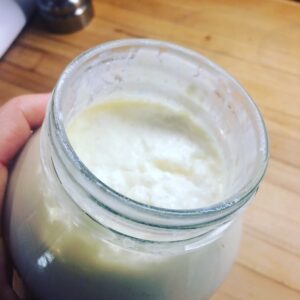

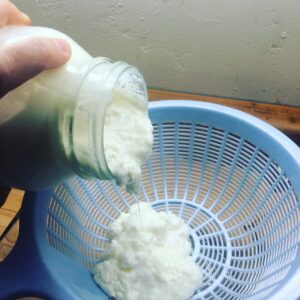
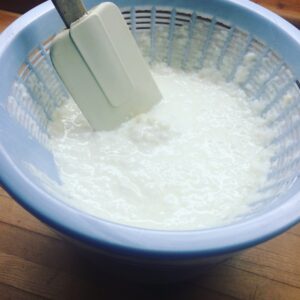
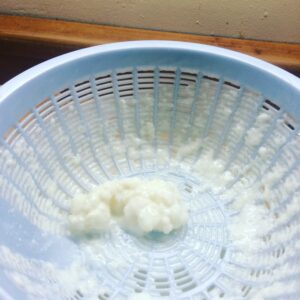



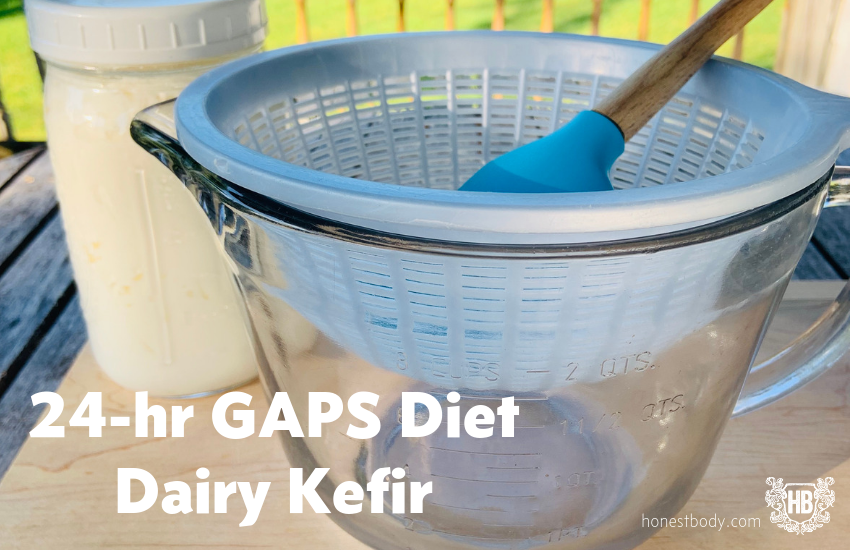
8 thoughts on “24 Hour Dairy Kefir”
How many Tablespoons of kefir grains do you use per quart of milk?
Hi Jennifer,
The amount of kefir grains are listed in the recipe. Thanks for your question!
Melanie
Hi Melanie, one of my favorite topics – Kefir Milk. I have been making my Kefir Milk for the last few years. I have made Kefir Cream Cheese by taking a large bowl. Place a clean dishcloth over the top and peg it down with pegs all around. Let it sag a bit. Pour a bottle of Kefir Milk into/onto the dishcloth. Cover it with another cloth and allow it to drip so that all the Whey (liquid) drips out and leaves the cream cheese on the dishcloth for you to scoop off. Sweet Chili is delicious on the cream cheese. It is important to know that the Whey is very healthy and when drinking the Kefir Milk, just mix the Kefir Milk before straining so that the grains remain but the Whey goes into your container with the Kefir Milk to make smoothies or drink plain. I absolute love my Kefir Grains an they are like Babies because they are alive and need to be fed and cared for…
Regards from Frances in South Africa
Hello Frances,
Thank you for sharing your love of kefir milk, and your experiences with making kefir cream cheese and using whey. I too love my kefir “babies” and will talk to them and even croon to them on occasion 🙂 It is amazing how they multiply and grow.
Kindly,
Melanie
How do you keep your grains alive if you have a lot of kefir to drink and you don’t want to make any more for a few days or a week?
Hi Amanda,
The best way to slow them down and keep them healthy is to put them in a clean jar with fresh milk and store them in the fridge for a few days, or week.
Kindly,
Melanie
Can kefir be consumed if I am sensitive to dairy?
Hi Jennifer.
Thanks for the question. It depends on what kind of dairy sensitivity you have. If it is a sensitivity to lactose, then you may be able to have 24-hr kefir, as during this process the beneficial bacteria & yeasts consume the lactose (or milk sugar).
Overall, it is a much more digestible form of dairy. If you try it, start with a very small amount. As with any probiotic food, kefir is full of beneficial microbes and can cause a “die-off” response.